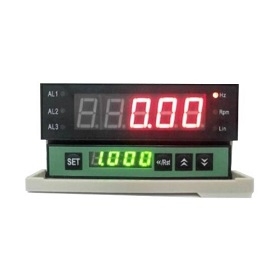A digital counter, often referred to simply as a "counter," is an electronic device used to count, display, and often control the number of events or objects as they occur. Counters are commonly used in various applications where it is necessary to keep track of quantities, frequencies, or occurrences. Digital counters are particularly useful because they provide accurate and easily readable numerical representations of the count. Understand their prices so you can make a better choice.
Basic Components
- Count Input: This is the signal input that the counter uses to increment or decrement its count. It could be pulses, clock signals, or any other input that triggers the counting process.
- Count Register: The count register is a digital storage element where the current count is stored. It is typically implemented using flip-flops or other digital storage devices. The count register stores the current count value in binary form.
- Decoder: A decoder is used to convert the binary count stored in the count register into a format that can be displayed on a numerical display, such as a 7-segment display or an alphanumeric display.
- Display: The display component shows the count value in a human-readable format. This can be a 7-segment LED display, an LCD display, or any other type of digital display technology.
Digital Counter Price List
To help you make a better choice, here is a price list of sisco online shop for you.
| Product picture | Product name | SKU | Price |
 |
Digital Counter, 4 Digit, Rev/ Frequency/ Speed | SISCO-DIGC-FA4D | $82.79 |
| Digital Counter, 4 Digit, Up/ Down, Number/ Batch/ Length | SISCO-DIGC-FH4D | $82.79 | |
| Digital Counter, 5 Digit, Rev/ Frequency/ Speed | SISCO-DIGC-FA5D | $89.14 | |
| Digital Counter, 6 Digit, Rev/ Frequency/ Speed | SISCO-DIGC-FA6D | $160.98 | |
| Digital Counter, 6 Digit, Up/ Down, Number/ Batch/ Length | SISCO-DIGC-FH6D | $89.14 | |
| Digital Counter, 8 Digit, Up/ Down, Number/ Batch/ Length | SISCO-DIGC-FH8D | $124.98 |
Advantages and Disadvantages
Advantages
- Accuracy: Digital counters provide high accuracy and precision in counting due to their binary representation of numbers. They are less susceptible to errors caused by noise or signal degradation.
- Reliability: Digital counters are generally more reliable than mechanical counters because they have no moving parts that can wear out or break over time.
- Versatility: Digital counters can be easily programmed or configured for various counting tasks, including up-counting, down-counting, and preset counting. They can also be integrated into complex digital systems.
- Speed: Digital counters can operate at high speeds and are capable of counting rapidly occurring events, making them suitable for applications where fast counting is required.
- Integration: They can be easily integrated with other digital components and microcontrollers, allowing for seamless data processing and control.
- Remote Monitoring: Digital counters can be equipped with communication interfaces, enabling remote monitoring and control of counting operations.
- Compact Design: Digital counters are typically more compact and space-efficient compared to their mechanical counterparts.
Disadvantages
- Power Dependency: Digital counters require a power source to operate, and in the event of a power failure, they may lose their count value.
- Initial Cost: Digital counters can be more expensive to purchase and install compared to simple mechanical counters.
- Complexity: More advanced digital counters can be complex to set up and configure, which may require a certain level of technical expertise.
- Limited Resolution: The resolution of a digital counter is finite and determined by the number of bits in the count register. In some cases, this may limit the counter's ability to accurately count very large or very small values.
- Sensitivity to Electrical Noise: Digital counters can be sensitive to electrical noise and interference, which can affect their accuracy. Proper shielding and noise-reduction techniques may be required in noisy environments.
- Limited Real-Time Display: Some digital counters may not provide real-time display updates for rapidly changing counts, which can be a limitation in certain applications.
- Limited Visual Feedback: The digital display used in many digital counters may not provide the same tactile and visual feedback as mechanical counters, which some users may prefer.
It's important to consider these advantages and disadvantages when selecting a digital counter for a specific application. The choice of counter type depends on the application's requirements, including accuracy, speed, reliability, and cost considerations.sisco.com provides high quality and high precision different types of digital counters to choose from, if you are interested in it, welcome to click, we provide professional service and consulting visits.

